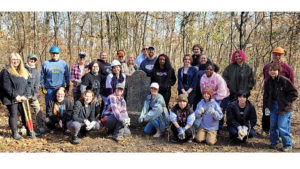HARRISBURG — Prior to the establishment of the Shawnee National Forest, small family farms dotted the southern Illinois landscape, forming communities that often centered around family connections, rural churches and consequently, cemeteries.

One such cemetery, where members of the pre-Civil War African American community of Miller Grove were laid to rest, recently received some much-needed maintenance. More than 25 volunteers gathered at Miller Grove Cemetery, on the Shawnee National Forest, to spruce up the overgrown community cemetery November 11, 2023.
The large group of volunteers was comprised of 21 Southern Illinois University (SIU) students from Sigma Phi Sigma (SPS)- mortuary sciences business fraternity, three Backcountry Horseman members, two from Shawnee Trail Conservancy, a River-to-River Trail Society member and one individual from Southern Illinois Mountain Bike Association.
The cemetery has not been host to a cleanup day for several years and volunteers were eager to peel back the overgrown vegetation.
SIU fraternity student, Jordan Pierce, president of Sigma Phi Sigma said, “Coordinating this work day for SPS has successfully fulfilled a personal goal of mine! I’ve always wanted to take part in a real cemetery restoration project. I am incredibly proud of everyone that donated their time to this project. It was hard work but so important.”
Before the work began Heather Carey, Shawnee National Forest Archaeologist, gave a brief introduction about the history of Miller Grove and its cemetery.
“These types of cemetery sites are of vital importance to understanding the past settlement patterns of southern Illinois,” Carey said. “They contain important historical information that often cannot be found elsewhere. In addition, maintaining cemeteries is a great way to honor and show respect for those that came before us.”
Located in Pope County, Miller Grove was a community established in the 1840s, primarily of freed African American slaves and free people of color. As more emancipated families joined the settlement, the community started by Harrison and Lucinda Miller grew, and soon contained a school, a church (Mt. Gilead African Methodist Episcopal) and accompanying cemetery.
The volunteers also learned about some of the different techniques’ archaeologists use to gather information in cemetery settings.
Martha Buchert, an Anthropology graduate student at SIU, also assisting that day, talked with the group about her thesis work which will include Miller Grove Cemetery, as well as another African American cemetery located on the Shawnee. Buchert will be conducting non-ground disturbing magnetometry to further explore patterns related to burial customs within historic African American communities.
When asked about how beneficial the volunteer’s work is to her studies, Buchert said, “I was thrilled to see such a strong turn out today. This will help greatly in facilitating the data I will be collecting out here.”
